The information below has been compiled from a variety of sources. If the reader has access to information that can be documented and that will correct or add to this woman’s biographical information, please contact the Nevada Women’s History Project.
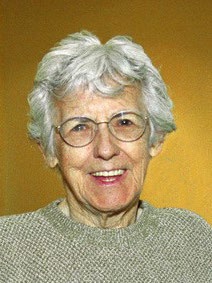
At a Glance:
Born: Overton, Nev., May 20, 1923
Died: Overton, Nev., April 19, 2015
Maiden Name: Betty Jane Whitehead
Race: Caucasian
Married: Leon Willis, August 15, 1951
Child: Marjorie Ann Willis
Primary City/County of Work:
Las Vegas, Clark County, Nev.
Major Fields of Work: Graphic design
Designer of iconic Las Vegas sign won fame but little fortune
When she started working in the arts, teaching dance on the side, and designing newspaper ads for Las Vegas shows, Betty Willis probably never thought that eventually she would design what has been heralded as the most recognizable sign in the world, “Welcome to Fabulous Las Vegas, Nevada.” Or that she’d hardly make a penny off that sign’s fame.
In 1905, Stephen R. and Gertrude Whitehead moved their family of eight children in a horse and buggy from the tiny town of Overton, Nev., to the not much bigger town of Las Vegas. They built the first two-story house in the town, and Stephen became the first elected assessor of Clark County. His youngest child Betty graduated from Las Vegas High School and decided to go to the Los Angeles Art Center in Pasadena, Calif., to learn more about her chosen field. She also took dance classes in Southern California, and when she returned, she opened a small dance studio in a local kindergarten class, as well as giving private lessons in “fox trot, waltz, and swing.” She worked as a legal secretary and deputy clerk in the 8th Judicial Court of the state of Nevada.
She married an electrician by the name of Leon Willis in 1951 and had one daughter, Marjorie Ann. The marriage didn’t last, and in 1957, she filed paperwork to terminate Leon’s parental rights.
She heard of an opening as a commercial artist at YESCO, a prominent Utah-based sign and advertising firm with an office in Las Vegas. She designed newspaper ads for casino shows and occasional signage. But when she moved to a company called Western Neon, she took an interest in the design of neon signs that were becoming more and more prevalent in “Sin City.” She designed signs by hand for many businesses, many of which no longer exist: the Blue Angel Motel and the Blue Heaven Bar, the Del Mar Motel, the Stardust Casino, the Normandie, the Bow and Arrow Motel, the Riviera, the Moulin Rouge, and the Mint casino.
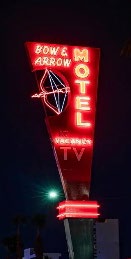
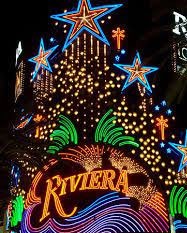

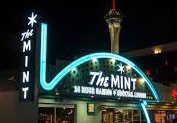
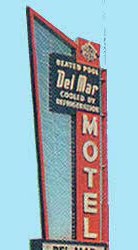
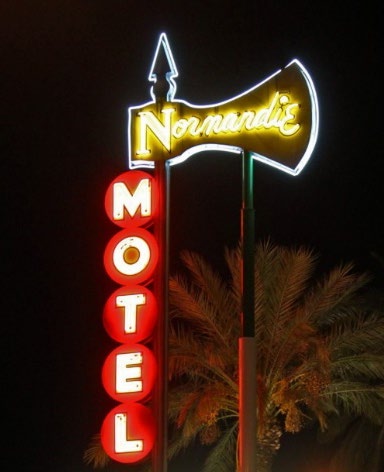

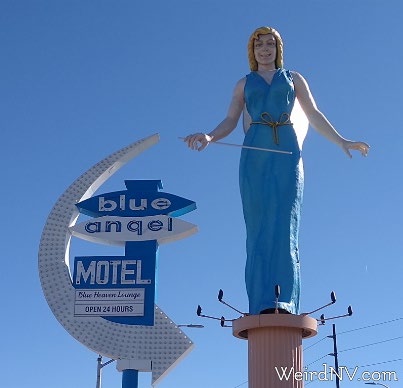
The Stardust and Riviera signs seem too modern.
In late 1958, she was approached by salesman and father of Nevada political power brokers, Sig Rogich, to design a welcoming sign for the city. She studied other signs around Nevada and Southern California for ideas. Up until then, the only such sign in southern Nevada was a wooden sign that read “Welcome to Las Vegas, the Gateway to the Boulder Dam.” He wanted something much flashier, so she used a diamond, a unique shape for a sign, and put it off-center on its supporting poles. She added flashing neon lights and silver dollars behind the letters of the word “Welcome,” in honor of Nevada’s history and title of the Silver State.
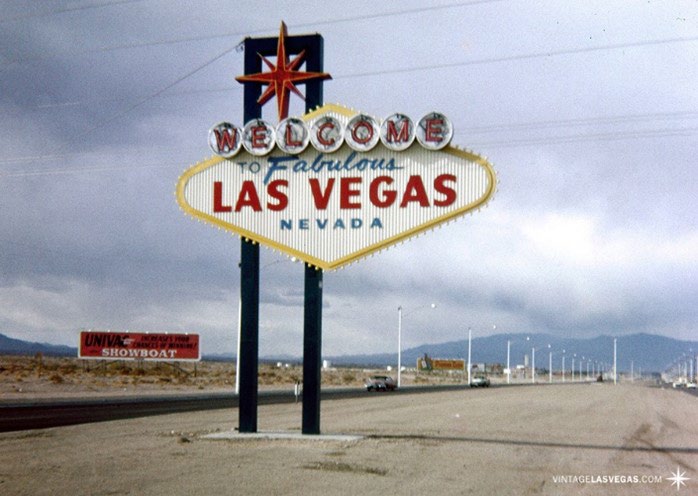
In a later interview with a blogger from the Neon Museum, she said, “They wanted something that would identify Las Vegas and be as exciting and welcoming as they could get. We put flashing lights, chasing neon, and everything we could to put action into it. The whole theme of the sign was to make people feel welcome. I added a Disney star on top for happiness and designed a shape that would be unusual. We know the sign would be recognizable because of the odd shape.”
In a different interview with the Las Vegas Review Journal, she said, “In those days, everything was done by hand. We laid a shape on tracing paper and made a blueprint.
Next, we took a silver pencil and drew a design on black mat board. To make the drawing resemble a neon sign, we first took white paint and outlined the lettering where neon went. Then we took an airbrush and sprayed color over the white to make it look like it was glowing.”
All that work garnered her only $90 a week in wages, which she remarked was “pretty good pay for a girl.” She commented later that most people were surprised to find out a woman had designed the sign. “It was a man’s business back then. It wasn’t a woman’s field because when you work with neon signs, you have to not only design them, but you have to learn the nuts and bolts of how neon, light, and electricity work. You have to learn about pressure points and weight and wattage of lamps. You work with engineers as well as artists. Most women back then weren’t interested in such technical stuff.”
The sign was commissioned by the Clark County Commission for $4,000 and put in the middle of the road south of the Strip, before there were any buildings out that way. Even then, people would stop in the middle of the road and take pictures in front of it as they drove into town.
Neither Willis nor Rogich ever trademarked the sign’s design, saying it was their gift to the city. In retirement, she joked, “I guess it would have been nice to have had the money, especially now that I’m an old geezer.” To which Rogich replied, “At just 10 cents a picture, we could have retired.”
The sign was eventually surrounded by buildings, including a small motel owned by John Woodrum. By the 1970s, it was not even lit up, as neon started to fade in popularity. But Woodrum himself ran a power line to it and turned it back on. People still stopped in the middle of the road to take pictures with it. So many, eventually, that the county finally decided to move the sign and build a large parking lot around it. There was some talk of taking it down at one point, but local outcry put that to rest.
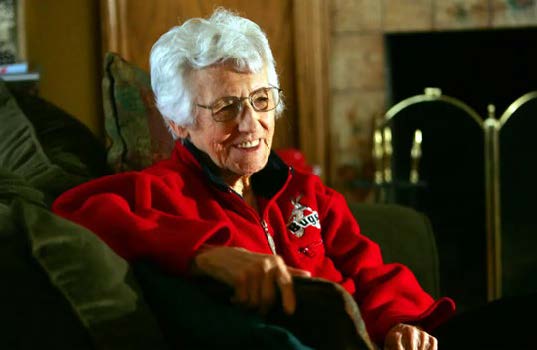
Not long after the sign went up, Western Neon was bought out by YESCO, unbeknownst to Betty, who was suddenly out of a job. She went to work for a company called Ad-Art, where she stayed for years. She continued working well into her 70s, joking, “If I win Megabucks, I’ll retire. But one thing seems certain…my sign will outlast me.”
And it did. In the 1960s, it began appearing as the unofficial city logo, used on the cover of the phone book, in TV shows, music videos, and it got its big screen debut in a thriller called “The Velvet Trap.” It was featured on a week of “Wheel of Fortune” television game show episodes. It’s been on a McDonald’s cup. It’s in the National Register of Historic Places. It was put on a Nevada license plate, with the proceeds going to charity, which made many millions of dollars for cultural and historical programs in Las Vegas. A small version of it was made and sold in local stores, with 5% of the proceeds going to cancer research. Slightly different versions of it can now be found in the Harry Reid (formerly McCarran) Airport and on the Boulder Highway. Willis tried to keep a scrapbook of its many adapted uses, but it became overwhelming, as were the “constant requests for me to take pictures in front of the sign with showgirls or something.”
The only money Willis made off the design came when she sold limited edition prints of a photo that she’d signed, and when she and her daughter sold silk-screened T-shirts with the design.
Willis volunteered her time to put on many presentations to arts organizations and cultural groups on her art and her design work. She was honored by the Las Vegas Centennial Committee at the S2 Art Center in downtown Las Vegas at its “50 Years of Fabulous Neon” celebration, where she called it “The little sign that could.”
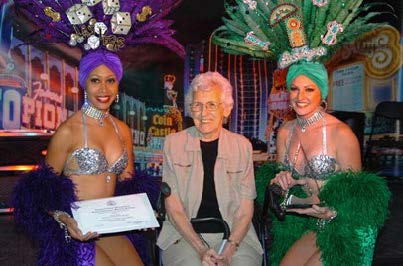
When members of the Nevada National Guard were in Kuwait, they recreated the Welcome sign for their camp and sent her a photo. She met them at Nellis Air Force Base when they returned from active duty.
In 2001, she moved back to Overton to work on a book, The Woman Behind the Sign, which was never published.
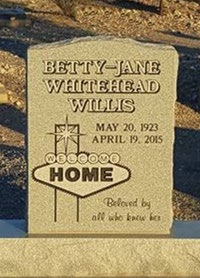
In April 2015, she passed away in her hometown, the last of her siblings to do so. She leaves behind her daughter Marjorie Holland and a few grandchildren. She is buried in Overton, Nev. at Pioneer Hill Cemetery, in Moapa Valley.
Researched by Patti Bernard and written by Kitty Falcone. Posted September 2023.
Sources of Information
- “Betty Willis (artist).” https://en.wikipedia.org/wiki/Betty_Willis_(artist)
- “Betty Willis Continues to Welcome the World to Las Vegas”, Las Vegas Review Journal (Las Vegas, Nevada), 11 June 1998 p.68.
- “Betty Willis: Neon Sign Artist.” The Neon Museum-Betty Willis.” Google, 24 March 2020, https://www.neonmuseum.org/the-collection/blog/betty-willis-neon-sign-artist
- “Betty Whitehead Starts Dance Studio.” Las Vegas Review Journal (Las Vegas, Nevada), 24 April 1947, p.15.
- “Betty Willis: The Woman Behind the Welcome to Las Vegas Sign-Culture Trip.” Google, Accessed 8 August 2022, https://theculturetrip.com/north-america/usa/nevada/articles/betty-willis-famous-sign-her-gift-to-las-vegas
- “Community Church Circles Hold Monthly Meetings.” Las Vegas Review Journal (Las Vegas, Nevada), 30 August 1956, p. 23.
- Find A Grave, Betty Jane Willis
content/view/120257876:60525?tid=&pid=&queryId=d9e7cb721de9db630c71366d1e82 2010&_phsrc=Z JS1847&_phstart=successSource, Memorial/14532996. - Haynes, Brian. “Those who made the neon of Vegas-Ceremony honors designers of signs that have identified city.” Las Vegas Review Journal (Las Vegas, Nevada), 7 October 2005, p. 4.
- Huffey, Dorothy. “Designers Educate Public on Neon’s Fabulous History.” Las Vegas Review Journal (Las Vegas, Nevada), 21 August 2003, p. 55.
- Juhl, Wesley. “Two figures in Las Vegas sign history die.” Las Vegas Review Journal (Las Vegas, Nevada), 21 April 2015, p. 14.
- Katsilometes, John. “Arts & Entertainment.” Las Vegas Review Journal (Las Vegas, Nevada), 7 October 2005, p. 123.
- Katsilometes, John. “Arts & Entertainment”, Las Vegas Review Journal (Las Vegas, Nevada, 9 Mar. 2007, p. 55.
- Kumler, Emily. “A Welcome Success.” Las Vegas Review Journal (Las Vegas, Nevada), 1 October 2004, p. 65.
- “Las Vegas: An Unconventional History.” Betty Willis (1924-2018), https://www.pbs.org/wgbh/americanexperience/features/lasvegas-willis/, as seen 8 August 2023.
Legal Notice. “A List of Claims.” Las Vegas Review Journal (Las Vegas, Nevada), 13 March 1950, p. 9.
Legal Notice. “Betty Jean Whitehead.” Las Vegas Review Journal (Las Vegas, Nevada), 13 March 1950, p. 9. - Legal Notice. “In the Matter of the Parental Rights…” Las Vegas Review Journal (Las Vegas, Nevada) 8 August 1957, p. 23.
- Legal Notice. “Kyra Egan, Plaintiff.” Las Vegas Review Journal (Las Vegas, Nevada), 13 June 13, 1949, p. 9.
- Legal Notice. “Leon G. Willis.” Las Vegas Review Journal (Las Vegas, Nevada), 15 August 1951, p.8.
“Miss Betty Whitehead.” Las Vegas Evening Review-Journal (Las Vegas, Nevada), 22 May 1944, p. 3. - “Moulin Rouge.” Las Vegas Review Journal (Las Vegas, Nevada), 15 August 2009, p. 17.
- “New Art League Class Slated for Monday.” Las Vegas Review Journal (Las Vegas, Nevada), 2 March 1958, p. 12.
- “Paying off for its Designer Half-Century Later.” Las Vegas Review Journal (Las Vegas, Nevada), 17 April 2008, p. 27.
- “To Betty Willis, Las Vegas was forever ‘Fabulous’.” The Kats Report. Las Vegas Sun (Las Vegas, Nevada), 20 April 2015.
- “Watercolor Society Annual Spring Show.” Las Vegas SUN (Las Vegas, Nevada), 4 May 1975, p. 12.

